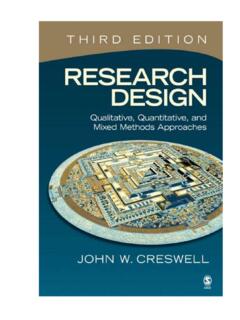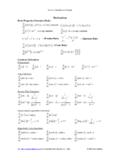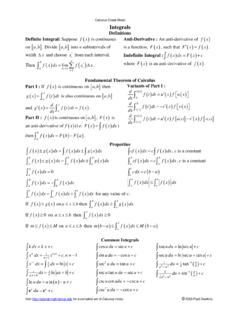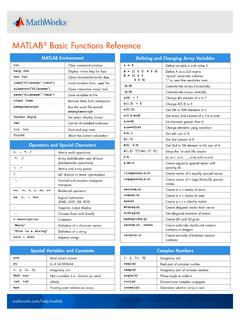Transcription of Cholesky decomposition - ucg.ac.me
1 Cholesky decompositionIn linear algebra, the Cholesky decomposition or Cholesky factorization is a decomposition of a Hermitian, positive-definite matrixinto the product of a lower triangular matrix and its conjugate transpose, which is useful for efficient numerical solutions, MonteCarlo simulations. It was discovered by Andr -Louis Cholesky for real matrices. When it is applicable, the Cholesky decompositionis roughly twice as efficient as the LU decomposition for solving systems of linear equations.[1]StatementLDL decompositionExampleApplicationsLinear least squaresNon-linear optimizationMonte Carlo simulationKalman filtersMatrix inversionComputationThe Cholesky algorithmThe Cholesky Banachiewicz and Cholesky Crout algorithmsStability of the computationLDL decompositionBlock variantUpdating the decompositionRank-one updateRank-one downdateAdding and Removing Rows and ColumnsProof for positive semi-definite matricesGeneralizationImplementations in programming librariesSee alsoNotesReferencesExternal linksHistory of scienceInformationComputer codeUse of the matrix in simulationOnline calculatorsThe Cholesky decomposition of a Hermitian positive-definite matrix A is a decomposition of the formContentsStatementwhere L is a lower triangular matrix with real and positive diagonal entries, and L* denotes the conjugate transpose of L.
2 EveryHermitian positive-definite matrix (and thus also every real-valued symmetric positive-definite matrix) has a unique Choleskydecomposition.[2]If the matrix A is Hermitian and positive semi-definite, then it still has a decomposition of the form A = LL* if the diagonal entriesof L are allowed to be zero.[3]When A has real entries, L has real entries as well, and the factorization may be written A = LLT.[4]The Cholesky decomposition is unique when A is positive definite; there is only one lower triangular matrix L with strictly positivediagonal entries such that A = LL*. However, the decomposition need not be unique when A is positive converse holds trivially: if A can be written as LL* for some invertible L, lower triangular or otherwise, then A is Hermitian andpositive closely related variant of the classical Cholesky decomposition is the LDL decomposition ,where L is a lower unit triangular (unitriangular) matrix, and D is a diagonal decomposition is related to the classical Cholesky decomposition of the form LL* as follows:Or, given the classical Cholesky decomposition , the form can be found by using the property that the diagonal of Lmust be 1 and that both the Cholesky and the form are lower triangles,[5] if S is a diagonal matrix that contains the maindiagonal of , thenThe LDL variant, if efficiently implemented, requires the same space and computational complexity to construct and use but avoidsextracting square roots.
3 [6] Some indefinite matrices for which no Cholesky decomposition exists have an LDL decomposition withnegative entries in D. For these reasons, the LDL decomposition may be preferred. For real matrices, the factorization has the form A= LDLT and is often referred to as LDLT decomposition (or LDLT decomposition ). It is closely related to the eigendecompositionof real symmetric matrices, A = Q is the Cholesky decomposition of a symmetric real matrix:And here is its LDLT decomposition :LDL decompositionExampleThe Cholesky decomposition is mainly used for the numerical solution of linear equations . If A is symmetric and positivedefinite, then we can solve by first computing the Cholesky decomposition , then solving for y byforward substitution, and finally solving for x by back alternative way to eliminate taking square roots in the decomposition is to compute the Cholesky decomposition , then solving for y, and finally solving .For linear systems that can be put into symmetric form, the Cholesky decomposition (or its LDL variant) is the method of choice, forsuperior efficiency and numerical stability.
4 Compared to the LU decomposition , it is roughly twice as of the form Ax = b with A symmetric and positive definite arise quite often in applications. For instance, the normalequations in linear least squares problems are of this form. It may also happen that matrix A comes from an energy functional, whichmust be positive from physical considerations; this happens frequently in the numerical solution of partial differential multi-variate functions may be minimized over their parameters using variants of Newton's method called quasi-Newtonmethods. At each iteration, the search takes a step s defined by solving Hs = g for s, where s is the step, g is the gradient vector ofthe function's partial first derivatives with respect to the parameters, and H is an approximation to the Hessian matrix of partialsecond derivatives formed by repeated rank-1 updates at each iteration. Two well-known update formulae are called Davidon Fletcher Powell (DFP) and Broyden Fletcher Goldfarb Shanno (BFGS).
5 Loss of the positive-definite condition through round-offerror is avoided if rather than updating an approximation to the inverse of the Hessian, one updates the Cholesky decomposition of anapproximation of the Hessian matrix Cholesky decomposition is commonly used in the Monte Carlo method for simulating systems with multiple correlated correlation matrix is decomposed, to give the lower-triangular L. Applying this to a vector of uncorrelated samples u produces asample vector Lu with the covariance properties of the system being modeled.[7]For a simplified example that shows the economy one gets from the Cholesky decomposition , say one needs to generate twocorrelated normal variables and with given correlation coefficient . All one needs to do is to generate two uncorrelatedGaussian random variables and . We set and .Unscented Kalman filters commonly use the Cholesky decomposition to choose a set of so-called sigma points. The Kalman filtertracks the average state of a system as a vector x of length N and covariance as an N N matrix P.
6 The matrix P is always positivesemi-definite and can be decomposed into LLT. The columns of L can be added and subtracted from the mean x to form a set of 2 Nvectors called sigma points. These sigma points completely capture the mean and covariance of the system least squaresNon-linear optimizationMonte Carlo simulationKalman filtersMatrix inversionThe explicit inverse of a Hermitian matrix can be computed by Cholesky decomposition , in a manner similar to solving linearsystems, using operations ( multiplications).[6] The entire inversion can even be efficiently performed non-Hermitian matrix B can also be inverted using the following identity, where BB* will always be Hermitian:There are various methods for calculating the Cholesky decomposition . The computational complexity of commonly used algorithmsis O(n3) in general. The algorithms described below all involve about n3/3 FLOPs, where n is the size of the matrix A. Hence, theyhave half the cost of the LU decomposition , which uses 2n3/3 FLOPs (see Trefethen and Bau 1997).
7 Which of the algorithms below is faster depends on the details of the implementation. Generally, the first algorithm will be slightlyslower because it accesses the data in a less regular Cholesky algorithm, used to calculate the decomposition matrix L, is a modified version of Gaussian recursive algorithm starts with i := 1 andA(1) := step i, the matrix A(i) has the following form:where Ii 1 denotes the identity matrix of dimension i we now define the matrix Li bythen we can write A(i) aswhereNote that bi b*i is an outer product, therefore this algorithm is called the outer-product version in (Golub & Van Loan).We repeat this for i from 1 to n. After n steps, we get A(n+1) = I. Hence, the lower triangular matrix L we are looking for is calculatedasComputationThe Cholesky algorithmIf we write out the equationwe obtain the following formula for the entries of L:The expression under the square root is always positive if A is real and complex Hermitian matrix, the following formula applies:So we can compute the (i, j) entry if we know the entries to the left and above.
8 The computation is usually arranged in either of thefollowing orders:The Cholesky Banachiewicz algorithm starts from the upper left corner of the matrix L and proceeds to calculatethe matrix row by Cholesky Crout algorithm starts from the upper left corner of the matrix L and proceeds to calculate thematrix column by pattern of access allows the entire computation to be performed in-place if that we want to solve a well-conditioned system of linear equations. If the LU decomposition is used, then the algorithm isunstable unless we use some sort of pivoting strategy. In the latter case, the error depends on the so-called growth factor of thematrix, which is usually (but not always) , suppose that the Cholesky decomposition is applicable. As mentioned above, the algorithm will be twice as fast. Furthermore,no pivoting is necessary, and the error will always be small. Specifically, if we want to solve Ax = b, and y denotes the computedsolution, then y solves the perturbed system (A + E)y = b, whereThe Cholesky Banachiewicz and Cholesky Crout algorithmsAccess pattern(white) andwriting pattern(yellow) for thein-placeCholesky Banachiewiczalgorithm on a5 5 matrixStability of the computationHere || ||2 is the matrix 2-norm, cn is a small constant depending on n, and denotes the unit concern with the Cholesky decomposition to be aware of is the use of square roots.
9 If the matrix being factorized is positivedefinite as required, the numbers under the square roots are always positive in exact arithmetic. Unfortunately, the numbers canbecome negative because of round-off errors, in which case the algorithm cannot continue. However, this can only happen if thematrix is very ill-conditioned. One way to address this is to add a diagonal correction matrix to the matrix being decomposed in anattempt to promote the positive-definiteness.[8] While this might lessen the accuracy of the decomposition , it can be very favorablefor other reasons; for example, when performing Newton's method in optimization, adding a diagonal matrix can improve stabilitywhen far from the alternative form, eliminating the need to take square roots, is the symmetric indefinite factorization[9]If A is real, the following recursive relations apply for the entries of D and L:For complex Hermitian matrix A, the following formula applies:Again, the pattern of access allows the entire computation to be performed in-place if used on indefinite matrices, the LDL* factorization is known to be unstable without careful pivoting;[10] specifically, theelements of the factorization can grow arbitrarily.
10 A possible improvement is to perform the factorization on block sub-matrices,commonly 2 2:[11]LDL decompositionBlock variantwhere every element in the matrices above is a square submatrix. From this, these analogous recursive relations follow:This involves matrix products and explicit inversion, thus limiting the practical block task that often arises in practice is that one needs to update a Cholesky decomposition . In more details, one has already computedthe Cholesky decomposition of some matrix , then one changes the matrix in some way into another matrix, say ,and one wants to compute the Cholesky decomposition of the updated matrix: . The question is now whether one can usethe Cholesky decomposition of that was computed before to compute the Cholesky decomposition of .The specific case, where the updated matrix is related to the matrix by , is known as a rank-one is a little function[12] written in Matlab syntax that realizes a rank-one update:function [L] = cholupdate(L, x) n = length(x); for k = 1:n r = sqrt(L(k, k)^2 + x(k)^2); c = r / L(k, k); s = x(k) / L(k, k); L(k, k) = r; L(k+1:n, k) = (L(k+1:n, k) + s * x(k+1:n)) / c; x(k+1:n) = c * x(k+1:n) - s * L(k+1:n, k); end end A rank-one downdate is similar to a rank-one update, except that the addition is replaced by subtraction.











